Aloha. I’ll tell you what, the only thing that’s slightly better than being the first speaker after lunch is being the last speaker before a break. It’s big shoes to follow VADM Terry Benedict. What an incredible subject matter expert. I’m just sitting there in awe, no notes, just rattling this stuff off. It’s extraordinary.
As the admiral said, I just came from Naples. I was over there talking to some folks last night about how it used to be this 60/40 split with 60 percent of the force in the Atlantic and 40 in the Pacific.
I talked to Admiral Tofalo in that job and was thinking, why don’t we have it that way now? I need all this force to go against the things that I’m trying to do over here in the EUCOM theater. Then they sent me over here to the Pacific, and now I’m trying to negotiate an 80/20 and will settle for a 70/30 split.
(Laughter).
But good morning and aloha from beautiful Pearl Harbor. While it’s always a shame to leave sunny Hawaii. it is great to be back in D.C. and an honor to speak in front of such a distinguished audience. Thank you to the Naval Submarine League and all you do to promote our submarine force and its contributions to our national security.
Events like this symposium and numerous local events across the country allow us all to stay engaged with today’s submarine force, educate the public, tell our story, and generate much needed support and understanding of our vital and special mission. I’ll echo my colleagues in congratulating Rear Admiral Padgett on his selfless service to the Naval Submarine League. He’s certainly a leader that knows all too well what a great job I have and how much fun it is to command in the Pacific.
Today I want to talk to you a little bit about our nation’s submarines, in line with this symposium’s theme of how we’re getting faster. In the Pacific we see our competitors in the undersea domain getting faster and more capable and more integrated each and every day. We’re making advances in all aspects of submarining, as you’ve heard, from so many of the speakers already, advances in design, in training and in our relationships with partners and allies.
We’re continuously improving our processes, focused on operations, and continue to adapt and innovate at every level to ensure we keep up with the changing strategic landscape. We’re doing this to remain the world’s pre-eminent maritime power, well ahead of our adversaries in the undersea domain.
So first I’d like to provide some context about what our adversaries are doing around the world. You can understand why it’s so important that we continue to invest in and develop the warfighting capabilities of our submarine force. I will then explain how we’re implementing our strategy to be the best in the world, getting better and faster in every theater of operation filled with threats that show no signs of slowing down.
So why is it so important to ensure that our submarine force is getting faster? Because our oceans have become one of the most contested regions in the world. In order to promote our national interests and protect our sea lines of communication, we must continue to adapt and develop our capabilities to ensure we remain the dominant undersea force. It is easy to see, based on the events over the past year, that our adversaries continue building their capabilities to thwart our regional influence, which challenges our ability to deliver strike forces at the time and place of our choosing.
The Russian navy has returned to operational tempos we haven’t seen since the Cold War in both the Pacific and the Atlantic. From open Defense Intelligence Agency reports, they have demonstrated advanced warfighting capabilities through land attack cruise missile launches in the Eastern Mediterranean, and the second deployment of the Severod- vinsk SSGN, one of the world’s most quiet and capable submarines. I have no doubt that the Russians want to bring these same capabilities to the Pacific fleet.
China continues its aggressive expansion of its capabilities. For instance, in a state run China Ocean News article, China reported its plans for a large underwater monitoring system designed to detect foreign ship movements and reduce the stealth advantage of our submarines. Their operations have continued to become more sophisticated, with longer, more frequent deployments, including sustained operations in the Indian Ocean.
North Korea remains an ever-present threat with its relentless and provocative nuclear tests. North Korea continues to pursue a submarine launched ballistic missile and development of the GORAE submarine as the launch platform. The proliferation of Russian and Chinese diesel submarines continues to grow as Vietnam and Bangladesh order Kilo class submarines, adding to the undersea congestion and the water- space management challenges.
We continue to see new players in the undersea spectrum, including the possibility of India acquiring a second Russian AKULA SSN. In total, 12 countries now operate submarines in the Pacific AOR. These events just touch the surface of what has become an incredibly complex and challenging area of operations for our undersea forces, with wide-reaching asymmetric and asynchronous consequences. So, let’s review some of these challenges a bit more in detail.
First, let’s talk China. China has invested heavily in not only the number of attack submarines it possesses, but also improving their tactical capability and operational integration as a maritime force.
The chart on the left shows the number and type of attack submarines in the Chinese navy. It is a submarine force coupled with a relative quieting ability, with green being the noisiest and red being the quietest. The green represents their initial ship classes: the ROMEO class, the MING class, and the nuclear-powered HAN and SHANG classes. The yellow represents diesel electric SONG class and the improved nuclear SHANG-class. The red indicates the newer KILOs and YUAN-class, the quietest submarines in the Chinese order of battle.
China is making the development of quieter submarines a priority that will create additional challenges to our maritime forces operating in the region. China has also demonstrated that it wants to equip its submarines with a strong offensive capability. The chart to the right indicates the percentage of Chinese submarines that are equipped with antiship cruise missiles. These missiles have the improved ability to threaten our surface ships from even greater distances.
According to a 2015 Department of Defense report to Congress, “the PLA navy recognizes that long range antiship cruise missiles require a robust over the horizon targeting capability to realize their full potential. China has, therefore, invested heavily in reconnaissance, surveillance, command and control, and communications systems at the strategic, campaign, and tactical levels to provide high-fidelity targeting information to surface and subsurface launch platforms.” Not seen on this slide are the Chinese ballistic missile submarines, the JIN class. So far, five JIN-class submarines have been launched, each with a capability to carry 12 or 16 ballistic missiles. The JIN-class provides China with a survivable second strike capability, enhancing their strategic deterrence capability and effectiveness.
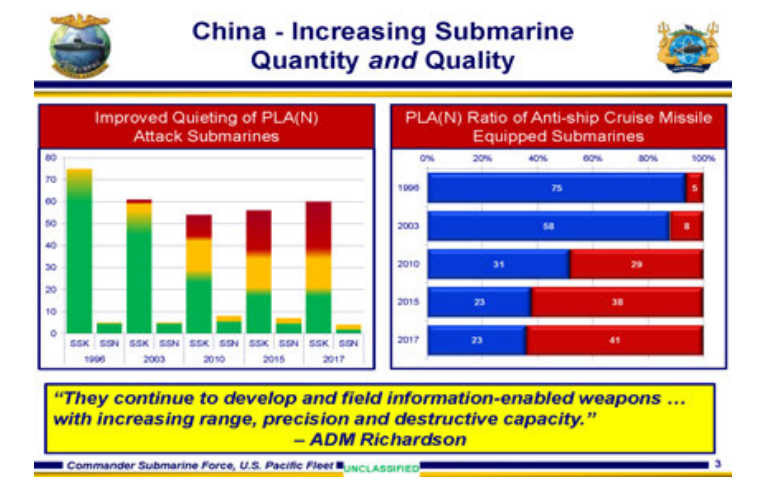
China has also significantly expanded the scope of its submarine operations. They have demonstrated great improvements in submarine endurance, conducting extended submarine deployments to the Indian Ocean every year since 2014. These multi month deployments are occurring where China is also routinely conducting coordinated surface force operations near their first overseas base in Djibouti. They are expanding their influence throughout the region with ship visits, port in- vestments, and military sales.
China is establishing a “Maritime Silk Road,” or as some have called it, a “String of Pearls,” through their “Belt and Road Initiative,” a maritime trade and transportation route reaching from the South China Sea and Indian Ocean to the Eastern Mediterranean, encompassing South and Southeast Asia, East Africa, and Near and Middle East, according to the Center for Strategic and International Studies.
China is clearly committed to exploiting the advantages of the undersea environment. I already spoke about the commitment to the seabased strategic asset with the JIN-class submarine, but these new types of operations, specifically the far seas patrols, will stress our theater anti-submarine warfare and maritime security efforts.
In addition, in the Congressional report on China’s modernization efforts, O’Rourke noted that future PRC forces will be land attack cruise missile capable, bringing an additional first strike threat to the regions with clandestine long- range precision guided munitions that we must contend with in coordination with our allies and partners.
Let’s shift to the threat that so many in this room spent their careers encountering, Russia. Recent events in the Ukraine and Syria demonstrate that the Russians have continued to develop advanced warfighting capabilities. The Russian navy, specifically its submarine force, is also

expanding its operations. As their submarine force continues to be modernized, we assess that the pace, scope and duration of their operations will increase as well.
The Russian military budget has doubled in the last decade. Their Navy’s goal is to rebuild their blue-water presence with their current shipbuilding priorities being based on modern nuclear submarines. Sim- ply said, nuclear submarines are their capital ships.
This shipbuilding and modernization strategy is designed to better enable Russia to defend its vast territory and national interests. Russia has demonstrated a new warfighting capability with its KALIBR missile. The KALIBR missile can be launched from submarines or surface ships and is built in land attack and anti-ship variants, with reported ranges between 200 and 1,500 nautical miles according to a report by the Center for Strategic and International Studies. Russia’s payload over platform strategy enables the KALIBR to be launched from nearly every ship in their Navy.
Until 2015, only the United States and the United Kingdom had used land attack cruise missiles in combat operations. Russia joined this elite group of nations with its launches into Syria in 2015.
While Russian submarine totals remain relatively constant, operational availability in the Pacific will go up as they continue to transfer forces, according to open reports from the Defense Intelligence Agency, specifically two of their DOLGORUKIY-class SSBN submarines, and eventually their highly capable SEVERODVINSK SSGNs to their Pacific fleet.
As stated earlier, North Korea continues its provocative actions with numerous nuclear tests and missile developments. North Korean leader Kim Jong-Un reported, through his state media, that he remains committed to “…establishing the equilibrium of real force with the United States,” through efforts to miniaturize the country’s nuclear weapons with the goal of developing a reliable way to deliver these weapons with greater ranges.
In August of 2016 North Korea successfully test launched a KN-11 submarine launched ballistic missile from a GORAE submarine. Based on a U.S. Strategic Command press release, this missile flew about 300 miles, entering Japan’s air defense identification zone just before splashing down in the Pacific Ocean.
While dependent on the operational range of the launch platform submarine, the Center for Strategic and International Studies estimates the KN-11’s maximum range to be nearly 1,100 nautical miles, which would allow North Korea to strike targets easily in South Korea and Japan. Due to the obsolescence of North Korea’s conventional military capabilities, the country has moved to a strategy based on weapons of mass destruction, an asymmetric capability including cyber-warfare. This strategy will create more uncertainty and instability in the region that will require our naval forces to be ready for an even larger number of possible contingencies.
In general, the continued, rapid development of naval capabilities by nations throughout the Indo-Pacific region has created many potential friction points that we must understand and address. During the 2016 Maritime Security Challenges Conference, Admiral Swift said, “As a rule, when nations apply sea power professionally and responsibly, it broadens national and regional prosperity alike. When seapower is applied provocatively and opportunistically, friction results with great potential for spiraling instability.”
The tracks on this chart show aggregated shipping density from Automatic Identification System data. Over half of the global shipping totals pass through the Indo-Pacific region. The Strait of Malacca alone handles 25 percent of all traded goods and 25 percent of all oil shipped globally.
The South China Sea is now one of the most congested areas on the planet. China, Vietnam, the Philippines, Taiwan, Malaysia have occupied 71 outposts in the Spratley Islands. Brunei also claims a portion of the archipelago but has no occupied outposts.
PRC outpost development in the Spratleys has increased significantly in recent years according to open source reports from the Office of Naval Intelligence and the 2016 annual Report to Congress from the Department of Defense. The PRC occupied seven outposts in 2014, but today has created or “reclaimed” more than 3,000 acres of land in the Spratley Islands, including the creation of several strategic outposts, while building up their military infrastructure and sustained presence on these outposts.
Make no mistake that the “infrastructure” they’re building consists of runways, communication and surveillance systems, and barracks to support revolving deployed forces, according to a 2016
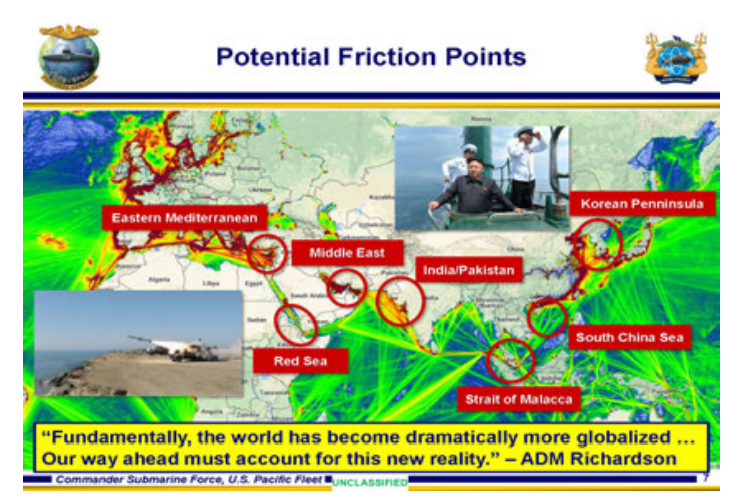
China Military Power report by the Department of Defense. This constitutes a contested Chinese military expansion into a body of water that plays host to $5.3 trillion of world trade each year and includes territorial claims by six countries.
Increased Chinese involvement in African and Middle Eastern affairs will lead to continued Chinese naval operations in the Indian Ocean, which will likely increase tensions between India and China as their forces operate in close proximity more frequently. Throughout the Pacific there are more nations putting naval forces to sea more frequently in heavily trafficked areas where there are competing interests and territorial claims. Miscalculation could rapidly create a flashpoint and military conflict. Our submarine force has to operate successfully in this challenging environment every day and be ready to respond immediately and decisively in any conflict.
So how is our Navy team getting ready for this ever present and complex threat of armed conflict? It starts with robust planning and prioritization efforts. Specifically, we’re planning to maximize flexibility. The 3rd and 7th Fleets were established March 15, 1943 to execute combat operations in the Western Pacific. Until 2015 3rd Fleet predominantly played a force generation role to provide forces to 7th Fleet, but today that has changed.
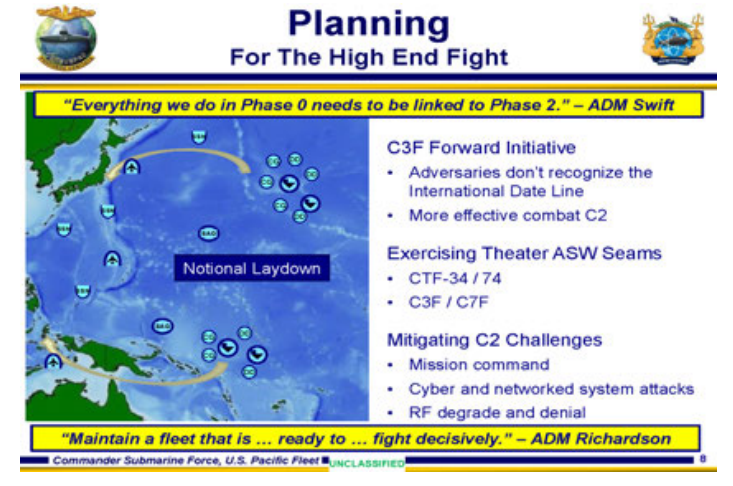
In 2015 Admiral Swift, the Pacific Fleet commander, established a wider role for 3rd Fleet when he announced 3rd Fleet Forward, making the administrative boundary at the International Date Line that traditionally separated 3rd and 7th Fleet, essentially transparent. The goal here, in line with planning for the high end, full spectrum fight, was to enable flexibility to our Command and Control structure and to increase our operational, decision making capacity.
The Pacific submarine force has always been at the leading edge of this fleet wide effort to get Command and Control right, without regard to arbitrary lines on a chart. Through exercises and real-world operations, COMSUBPAC routinely and seamlessly provides ready forces and acts as the operational commander, theater-wide in close coordination with my 7th Fleet counterparts.
Our submarine force continues to adapt its operations to overcome Command and Control challenges that have arisen from recent improvements in our adversaries’ technical capabilities. Specifically, the ability to conduct sustained attacks on our cyber and networked systems, as well as degrade or deny our navigation and communication signals, has the potential to significantly disrupt maritime operations. Despite these challenges we continue to plan and develop counter capabilities across the DOTMLPF so that our submarines can accomplish their missions, regardless of the environmental conditions.
Our success in the high end fight depends not only on how we plan, but also how we prepare, each and every day. In the Pacific Submarine
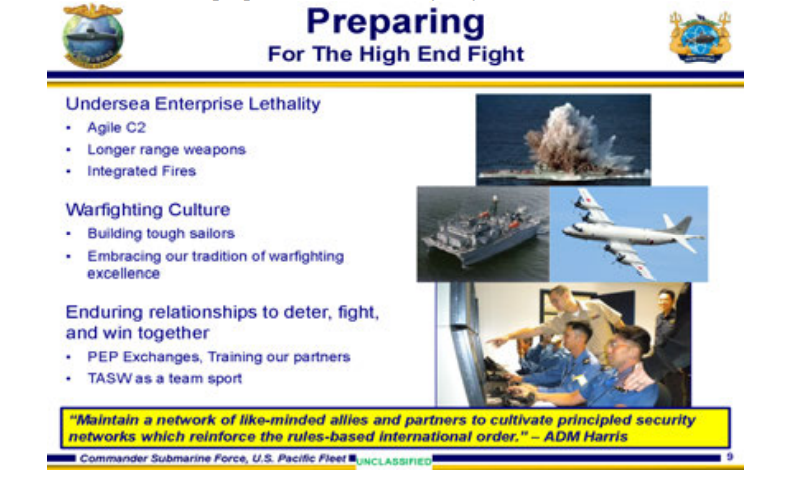
Force, I’m pursuing a strategy that reinforces and improves the lethality of our undersea enterprise. By the way, I’ll just pause here for a second just to say that Admiral Fluckey was a “bad-ass.” Stay with me.
Our warfighting design will allow us to rapidly and successfully respond to any conflict. Our new weapons will enable us to be lethal from even greater distances. Technological advances in our combat systems will make our weapons more cost efficient, while improving our performance as an integrated element within the joint forces kill chain.
Our submarine force is embracing and renewing a warfighting culture of toughness in everything we do. We are framing our missions, our exercises, and our competency development efforts in the context of war fighting in order to give our sailors and officers the proper context, perspective, a strong sense of ownership, and a clear vision that focuses the energy we apply every day to personnel and material readiness.
We are also building enduring and trustworthy relationships with our allies so that we can deter, defend and win together. We have shown our commitment to our allies through personnel exchange programs, information sharing, and joint Theater anti submarine warfare operations, reinforcing the concept that submarine operations are a team sport. These specific partnerships are crucial to maintaining our shared prosperity and mutual defense.
Like any great sports team, the submarine force knows the importance of practice. And our practice is expertly tailored to ensure the success of our forces in the Pacific against the many threats I’ve described. Numerous exercises such as TALISMAN SABRE and Carrier Strike Group Fleet Problems are stressing the submarine’s role in combat, further defining our place within the Fleet’s integrated operational model. We also continue to conduct joint exercises with our allies in the region so that we are prepared, together, for any possible conflict.
As Admiral Tofalo mentioned, we have adapted our Tactical Readiness Evaluations (TRE) to emphasis and highlight our warfighting readiness to ensure our submarines are successfully prepared for combat operations during conflict and hostile contingencies. Our submarine command force, where we train our Prospective Commanding and Executive officers for their roles in leading our submarine force, continues to be the best in the world, a “hands on” laboratory for stressing decision-making and for testing innovations in tactics and techniques that can be rapidly integrated into force doctrine to improve our effectiveness in combat.
We are continuing to advance our sensor technologies to ensure our submarines can detect and track adversaries in order to hold them at risk at even greater distances.
We are practicing and exercising new capabilities that have arisen from technological advancements. In September of this year, as has been mentioned a few times throughout this symposium, I went up personally to stand up Unmanned Undersea Vehicle Squadron ONE, the first of its kind. UUV technology will help us perform across, in, and through the spectrum of today’s challenging missions and operations.
The establishment of the first UUVRON will ensure we can expertly implement, manage, and sustain this new technology as necessary to support the undersea fight with the right subject matter experts and Command and Control structure ready to leverage these emerging and force multiplying systems.
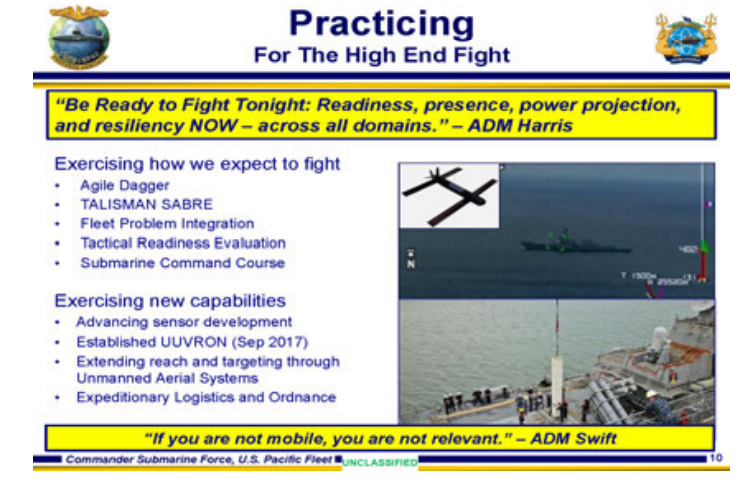
The picture you see here is an unmanned aerial vehicle launched from a submarine, which is designed to improve our submarine’s organic situational awareness of the battlespace.
Finally, we’ve begun implementing our expeditionary logistics and ordnance model. Our tenders can service all classes of vessels but are primarily submarine repair assets. The Tender provides a sovereign, mobile, nuclear capable work site able to deal with emergent material issues overseas. They also provide a mobile repair, re arming and replenishment capability to fleet commanders when needed. This new logistics model will ensure our submarines can sustain and return to the fight faster than ever.
The home port change of the Emory S. Land to Guam in December of 2015 has allowed us to always have one Tender in Guam to support the four SSNS home ported there, as well as our deployed submarines. The tenders are on a rotational deployment model, where one stays in Guam to tend homeported submarines and deployed SSGNs and SSNs, while the second tender deploys for expeditionary maintenance throughout the 5th and 7th Fleet areas of responsibility.
While practice is no doubt important, we cannot continue to dominate the undersea domain unless we critically assess our performance, so we can continue to make constant and enduring improvements. Our assessments are a vital piece of our operational battle rhythm that identify and correct vulnerable areas before they significantly degrade our readiness. Our inspections are some of the most rigorous in the Navy, and the feedback we get from this thorough approach ensure our crews have a deep understanding of any system deficiency in order to affect corrective actions and retests before being challenged in combat.
Our Submarine Squadrons exemplify and practice an intrusive leadership model. A hands-on approach that ensures maximum awareness of any and all issues on each submarine that allows me to build Force-wide solutions designed to focus, target, and apply additional effort to address weak areas as a natural part of our readiness model.
Our force conducts extensive road shows, regularly sending senior leaders to our waterfronts to pass on lessons learned from major mis-haps, while emphasizing and illuminating our commander’s intent.
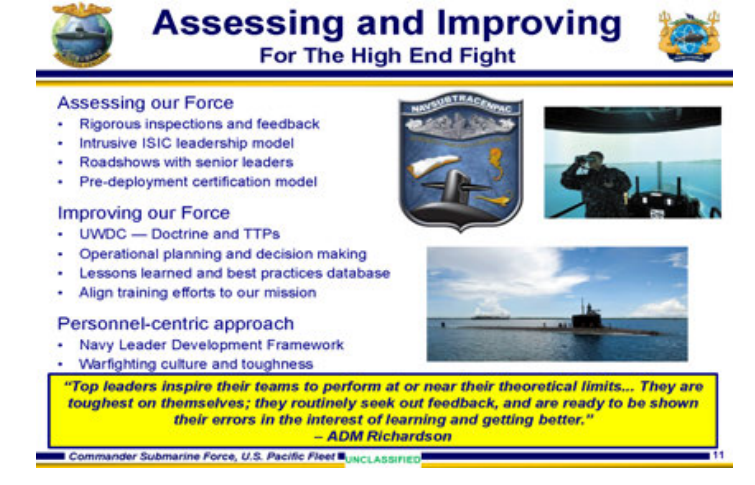
Similar to our inspection process, our comprehensive pre-deployment certification model ensures that before we wave farewell to our submarines, when they leave the pier, that they have the best equipment, knowledge and culture to be successful.
However, these assessments would not generate lasting effects to the problems we identify without a way to capture formally, the lessons learned and best practices. Through the standup of the Undersea Warfghting Development Center and I see my good friend, Admiral Jimmy Pitts, in the audience we’ve centralized our efforts to develop and publish warfighting doctrine. This streamlined process has been a force multiplier in enabling rapid and effective advances of my primary objective, which is to generate the best Forces available for operational commanders to utilize in peacetime missions with the readiness, training, and toughness to succeed as warfighters.
We continue our drive to capture critical lessons learned from every event and exercise, and feed those back into our doctrine to affect meaningful change and improvements to the Force, as fast as possible. Drawing from this regularly improving doctrine, our training is expertly aligned to our mission sets so that our submarines and crews possess the specialized knowledge and experience necessary across the spectrum of their unique tasking.
We are able to conduct these assessments and improvements successfully through effective leadership and a personnel centric approach; creating a culture that fosters excellence in warfighting through critical self assessment and continual evaluation of our organization, doctrine, training, and policies.
This pillar of our force is directly in line with our CNO’s guidance, published in his Navy Leader Development Framework earlier this year when he wrote, “Top leaders inspire their teams to perform at or near their theoretical limits. They are toughest on themselves; they routinely seek out feedback, and are ready to be shown their errors in the interest of learning and getting better.” As we grow and evolve as a Force our culture of assessment and continuous improvement is as important as ever, especially in an effort to evolve quickly and win against ever improving adversaries.
Lastly, our submarine force cannot hope to be successful in any high end fight without resilient Sailors. Our nation is blessed because
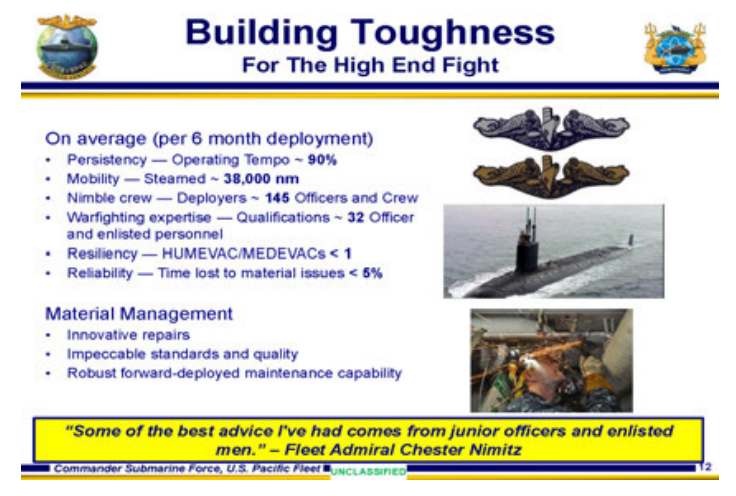
our submarine force has the most outstanding and toughest sailors in the world. All you have to do is look at the numbers for an average six month deployment to conclude that our Sailors are the best the nation has to offer.
On average, our submarines steam over 38,000 nautical miles each deployment. For reference, the circumference of the Earth is 21,600 nautical miles, so our submarines nearly circumnavigate the Earth twice each deployment! No matter the operational tempo, no matter how many consecutive days at sea, our sailors do not break. In fact, they excel and grow as undersea warriors.
They continue to qualify and improve themselves as both professionals and individuals. They possess self sufficiency unrivaled by any other nation. It seems as though at every post deployment brief I attend I hear a new story of how a boat came up with some incredible method to maintain material readiness in order to remain on station and complete its mission vital to national security.
It’s just not our personnel repairing their systems, but the materials themselves that continue to exceed expectations. On a typical deployment we lose less than five percent of our operational days due to material issues. In fact, just this past year, as Admiral Caldwell discussed
yesterday, the USS Jacksonville, the second oldest boat in our Force, launched in 1978, completed an almost eight-month deployment with zero days lost due to material problems. This is a testament to both the outstanding design and quality we demand during the construction of our ships, and to the nearly 40 years of superb maintenance by our sailors and maintenance facilities. It is this sense of ownership and flexibility to ensure the job gets done right that makes our submarine force so successful, no matter the challenge or conflict.
There is no doubt that our submarine force is operating in one of the most complex and demanding environments we have ever faced. With so many of our adversaries building up their forces and aggressively attempting to strengthen their global position, it may seem like the challenges that our nation faces are too great for our military to handle.
However, with our incredible Sailors, our extraordinary submarines, and our dedication to continuously adapt and overcome, we will continue to stay ahead of the curve. Everyone here today should have complete confidence that our submarine force will always get better, get more capable, and certainly “get faster” in order to promote our values and protect our nation’s interests.
I really appreciate the opportunity for allowing me to speak and provide some insights today, and I open the floor to any questions.

